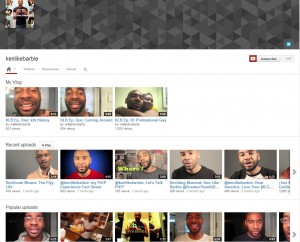Using Video to Share your Story: An Interview with KenLikeBarbie
We’ve previously featured Ken Williams’ videos on this blog. As an African American man living with HIV, Ken uses YouTube, Twitter, Facebook, and Instagram to share his story. As we approach National HIV Testing Day on June 27, we sat down with Ken (actually, we “hungout” on Google+) to learn more about how he uses new media to share his story, how it’s been received, and what’s next for him and his work.

HIV.gov: Will you please explain how you use new media to share your story?Ken: I went to art school for my undergrad and I wanted to keep creatively active, so I started recording my life. When I became HIV positive in 2010, I was already a “YouTuber” for the gay community, particularly here in Chicago. And I thought that if I was going to continue to be honest about my story, that I should capture the process I went through after I was diagnosed with HIV. It was a process of re-understanding, rediscovering, re-loving myself. I wanted to capture that on my YouTube channelExit Disclaimer because that was the medium I was already using. FacebookExit Disclaimer, TwitterExit Disclaimer, and InstagramExit Disclaimer have all play a role in helping me share my story.
HIV.gov: How has your work been received by your followers?
Ken: New media is on 24/7 and people seem to always be looking for information about HIV/AIDS and wanting to get to to know the HIV/AIDS community. My hope is that my videos offer encouragement and support for people living with HIV. In turn, I also receive support from the community. Through my videos, I have met so many people. I have an HIV.gov family now. A Houston family. A YouTube family. And it keeps growing!
HIV.gov: Can you tell me a little more about you when you are not creating and sharing your YouTube videos?
Ken: I work for Test Positive Awareness NetworkExit Disclaimer (TPAN). I am a prevention specialist doing HIV testing and counseling. I’ve created several videos that I also use when I facilitate groups and deliver education sessions, such as the video, HIV Fact SheetExit Disclaimer, My PrEP Experience Fact SheetExit Disclaimer, and Consider Me John DoeExit Disclaimer. The John Doe video addresses my HIV medication adherence, which is an important part of my own continuum of care (which we know is also an important part of the treatment cascade).
HIV.gov: What’s next for KenLikeBarbie?
Ken: At TPAN we are very busy this month with National HIV Testing Day. That’s what is happening in my immediate future. I’m glad that my videos and my story can encourage people to know their status and I hope that they continue to inform and educate people about HIV. In the long term, I would like for what I do to have a larger reach. New media continues to grow so I have faith that my videos will continue to reach people with important HIV information.
HIV.gov: Thank you Ken for sharing your story with us and everyone else for National HIV Testing Day.
Whether it’s YouTube, Facebook, your personal support network, or even finding support service using our HIV Testing and Care Services Locator, there are many resources available for National HIV Testing Day (and every day) to help you know your status, get support, and live a healthy life.